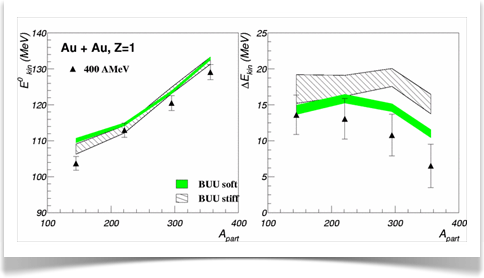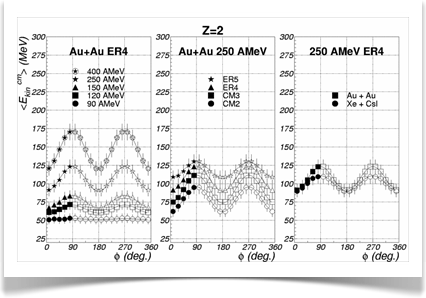



FOPI
A Detector for Physics of Nuclear Reactions at Intermediate and Relativistic Energies
Azimuthal dependence of collective expansion for symmetric heavy ion collisions
The large phase-space coverage of Phase II of the FOPI detector at GSI-Darmstadt, allowed to extend our previous studies on the participant-zone dynamics from central to mid-central heavy-ion collisions. Detailed studies of azimuthal dependence of the mean fragment and flow energies in the Au+Au and Xe+CsI systems were studied as a function of incident energy and centrality.
Figure 6 presents, as an example, the azimuthal dependence of Ecmkin for Z=2 products as a function of the incident energy in Au + Au at ER4 centrality, as a function of centrality in Au + Au at 250 AMeV, and for the two measured systems at 250 AMeV and ER4 centrality. Two windows in the CDC Multiplicities CM2 and CM3, have been used to select impact parameters in the range of 6-8 fm and 4-6 fm and the ER4 and ER5 windows in Erat ( Erat =åj EI j /EII j), ( S )ratio of transverse and longitudinal energies in the c.m. system) have been used to select the ranges 2-4 fm and 0-2 fm, respectively.
The large phase-space coverage of Phase II of the FOPI detector at GSI-Darmstadt, allowed to extend our previous studies on the participant-zone dynamics from central to mid-central heavy-ion collisions. Detailed studies of azimuthal dependence of the mean fragment and flow energies in the Au+Au and Xe+CsI systems were studied as a function of incident energy and centrality.
Figure 6 presents, as an example, the azimuthal dependence of Ecmkin for Z=2 products as a function of the incident energy in Au + Au at ER4 centrality, as a function of centrality in Au + Au at 250 AMeV, and for the two measured systems at 250 AMeV and ER4 centrality. Two windows in the CDC Multiplicities CM2 and CM3, have been used to select impact parameters in the range of 6-8 fm and 4-6 fm and the ER4 and ER5 windows in Erat ( Erat =åj EI j /EII j), ( S )ratio of transverse and longitudinal energies in the c.m. system) have been used to select the ranges 2-4 fm and 0-2 fm, respectively.


Mean c.m. energy (Ecmkin)of Z=2 products as a function of the azimuthal angle, shown for: Au+Au at ER4 centrality and different energies (left); Au+Au at 250 AMeV and different centralities (middle), and Au+Au and Xe+CsI at 250 AMeV and ER4 centrality (right). The error bars include systematic effects.

As shown by the solid lines, the data follow very well the behaviour
Comparisons between data and model calculations show that the flow energy values along different azimuthal directions could be viewed as snapshots of the fireball expansion with different exposure times.
For the same number of participating nucleons more transversally elongated participant shapes from the heavier system produce less collective transverse energy.
Comparisons between data and model calculations show that the flow energy values along different azimuthal directions could be viewed as snapshots of the fireball expansion with different exposure times.
For the same number of participating nucleons more transversally elongated participant shapes from the heavier system produce less collective transverse energy.
For the 400 AMeV Au+Au collisions Figure shows the results of the Boltzmann- Uehling-Uhlenbeck (BUU) transport code [1], using momentum dependent mean fields (m*/m=0.79), in-medium elastic cross sections ( with ) and soft (K=210 MeV, gray zone) or stiff (K=380 MeV, dashed zone) EoS. Good agreement with BUU calculations is obtained for a soft nuclear equation of state.
and as a function of , for Z=1 (A=1,2,3) fragments, Au+Au at 400 AMeV. The experimental results are represented by triangles, the BUU results are represented by gray zones for soft EoS and dashed zones for stiff EoS, respectively.
and as a function of , for Z=1 (A=1,2,3) fragments, Au+Au at 400 AMeV. The experimental results are represented by triangles, the BUU results are represented by gray zones for soft EoS and dashed zones for stiff EoS, respectively.

References:
1. P. Danielewicz and Q. Pan, Phys. Rev. C 46 (1992) 2002, P. Danielewicz, Nucl. Phys A 673 (2000) 375
1. P. Danielewicz and Q. Pan, Phys. Rev. C 46 (1992) 2002, P. Danielewicz, Nucl. Phys A 673 (2000) 375
